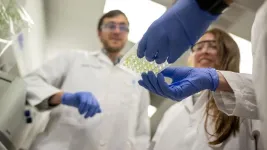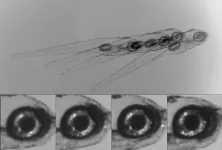(Press-News.org) A groundbreaking method for bridge construction is set to enhance performance, reduce construction time, and cut costs for future bridges across Texas.
Dr. Kinsey Skillen, assistant professor in the Civil and Environmental Engineering Department at Texas A&M University, was named Principal Investigator (PI) of the Texas Department of Transportation (TxDOT) research project titled “Develop/Refine Design Provisions for Headed and Hooked Reinforcement.”
The 42-month project, which received nearly $1 million in funding, is a joint effort between the Texas Transportation Institute and the University of Texas at San Antonio (UTSA) exploring more efficient methods of anchoring steel reinforcement in bridge structure joints to enhance structural performance and accelerate construction timelines.
One specific bridge structure being researched, known as a “straddle bent,” consists of two large columns and a beam to support elevated roadways. The reinforcing steel that joins the beam to the columns currently requires meticulous design and construction considerations. This research aims to provide TxDOT with updated design guidelines for using hooked and headed bars in bridge structures, supported by full-scale experimental testing.
An innovative approach currently under evaluation is the use of “headed bars,” which are reinforcing bars with a large nut-like head attached at the bar end to prevent it from being pulled out of the concrete. Full-scale straddle bent joints incorporating headed bars are currently undergoing construction and testing at the Center for Infrastructure Renewal’s High-Bay Laboratory.
This study will be the first of its kind to establish design provisions for the use of headed reinforcement in bridge structure applications, offering TxDOT bridge engineers robust design guidance for future projects.
Additional tests are being conducted at the Large-Scale Testing Laboratory at UTSA, led by Co-PI Dr. Adolfo Matamoros. Such tests focus on further understanding the load transfer mechanisms provided by hooked and headed bars in additional TxDOT bridge applications.
Skillen specializes in large-scale structural testing and the behavior of reinforced concrete structures. His research interests include field monitoring of structures, bond and anchorage of steel reinforcement, strengthening existing structures, shear and torsion, and structural applications of ultra-high-performance concrete.
By Katie Carroll, Texas A&M Engineering
###
END
New research aims to improve bridge construction in Texas
Texas A&M Engineer Dr. Kinsey Skillen leads a new 42-month TxDOT research project at the Center for Infrastructure Renewal.
2025-01-02
ELSE PRESS RELEASES FROM THIS DATE:
These bacteria perform a trick that could keep plants healthy
2025-01-02
To stay healthy, plants balance the energy they put into growing with the amount they use to defend against harmful bacteria. The mechanisms behind this equilibrium have largely remained mysterious.
Now, engineers at Princeton have found an answer in an unexpected place: the harmless, or sometimes beneficial, bacteria that cluster around plants’ roots.
In an article published Dec. 24 in the journal Cell Reports, researchers showed that some types of soil bacteria can influence a plant’s ...
Expanding the agenda for more just genomics
2025-01-02
Genomics is being integrated into biomedical research, medicine, and public health at a rapid pace, but the capacities necessary to ensure the fair, global distribution of benefits are lagging. A new special report outlines opportunities to enhance justice in genomics, toward a world in which genomic medicine promotes health equity, protects privacy, and respects the rights and values of individuals and communities.
The report, “Envisioning a More Just Genomics,” is a collaboration between ...
Detecting disease with only a single molecule
2025-01-02
UC Riverside scientists have developed a nanopore-based tool that could help diagnose illnesses much faster and with greater precision than current tests allow, by capturing signals from individual molecules.
Since the molecules scientists want to detect -- generally certain DNA or protein molecules -- are roughly one-billionth of a meter wide, the electrical signals they produce are very small and require specialized detection instruments.
“Right now, you need millions of molecules to detect ...
Robert McKeown recognized for a half century of distinguished service
2025-01-02
NEWPORT NEWS, VA – For nearly half a century, Robert D. “Bob” McKeown has probed nuclear particles and educated rising generations of physicists. Now, the former deputy director for science at the U.S. Department of Energy’s Thomas Jefferson National Accelerator Facility is being honored for his outstanding career contributions with the 2024 American Physical Society’s Division of Nuclear Physics (DNP) Distinguished Service Award.
McKeown is recognized for his work in experimental physics and his extensive leadership in the broader ...
University of Maryland awarded $7.8 million to revolutionize renewable energy for ocean monitoring devices
2025-01-02
University of Maryland researcher Stephanie Lansing received a Phase 1 $7.8M award from Defense Advanced Research Projects Agency (DARPA) to develop and test a biologically fueled energy source to power research and sensing devices throughout the world’s oceans.
There is a vast array of ocean sensing devices that provide critical information for understanding marine environments, monitoring climate change and maintaining national security. Many of these sensors are currently powered by long underwater cables or lithium-ion batteries.
Lansing is leading a large, collaborative effort that will overcome the need for batteries and ship-based or shore-based ...
Update: T cells may offer some protection in an H5N1 ‘spillover’ scenario
2025-01-02
Update: This LJI study was previously shared on bioRxiv in September 2024. Since then, health officials have reported a rise in H5N1 “bird flu” infections in humans, including the first severe H5N1 human case requiring hospitalization. Officials have also reported increased cases in feline species, including an outbreak among big cats at a wildlife sanctuary. In California, the recent spread of H5N1 to dairy herds in Southern California prompted Gov. Gavin Newsom to declare a “State of Emergency” on Dec. 18, 2024.
LA JOLLA, CA—New research led by scientists at La Jolla Institute for Immunology (LJI) ...
Newborn brain circuit stabilizes gaze
2025-01-02
An ancient brain circuit, which enables the eyes to reflexively rotate up as the body tilts down, tunes itself early in life as an animal develops, a new study finds.
Led by researchers at NYU Grossman School of Medicine, the study revolves around how vertebrates, which includes humans and animals spanning evolution from primitive fish to mammals, stabilize their gaze as they move. To do so they use a brain circuit that turns any shifts in orientation sensed by the balance (vestibular) system in their ears into an instant counter-movement by their eyes.
Called ...
Bats surf storm fronts during continental migration
2025-01-02
Birds are the undisputed champions of epic travel—but they are not the only long-haul fliers. A handful of bats are known to travel thousands of kilometers in continental migrations across North America, Europe, and Africa. The behavior is rare and difficult to observe, which is why long-distance bat migration has remained an enigma. Now, scientists from the Max Planck Institute of Animal Behavior (MPI-AB) have studied 71 common noctule bats on their spring migration across the European continent, providing a leap in understanding this mysterious behavior. Ultra-lightweight, intelligent sensors attached ...
Canadian forests are more prone to severe wildfires in recent decades
2025-01-02
Climate change is driving more intense wildfires in Canada, according to a new modeling study, with fuel aridity and rising temperatures amplifying burn severity, particularly over the last several decades. The findings underscore the growing impact of climate change on wildfire behavior, with the most severe effects concentrated in Canada’s northern forests. Fueled by ongoing climate change, Canada – one of the most forested and fire-prone regions in the Northern Hemisphere – is grappling with increasingly severe and prolonged wildfire seasons. ...
Secrets of migratory bats: They “surf” storm front winds to save energy
2025-01-02
A species of migrating bat “surfs” the warm winds of incoming storm fronts to conserve energy, according to a study that used tags to track the tiny animals on their long journeys across central Europe. The findings offer new insights into how weather, physiology, and environmental factors shape bats’ seasonal migration patterns. While bird migration is well-documented and studied, this is not the case for seasonal migration of bats – particularly the few long-distance, migratory species. These nocturnal travelers face substantial challenges, ...
LAST 30 PRESS RELEASES:
Reducing social isolation protects the brain in later life
Keeping the heart healthy increases longevity even after cancer
Young adults commonly mix cannabis with nicotine and tobacco
Comprehensive review illuminates tau protein's dual nature in brain health, disease, and emerging psychiatric connections
Book prepares K-12 leaders for the next public health crisis
Storms in the Southern Ocean mitigates global warming
Seals on the move: Research reveals key data for offshore development and international ecology
Sports injuries sustained during your period might be more severe
World's first successful 2 Tbit/s free-space optical communication using small optical terminals mountable on satellites and HAPS
Can intimate relationships affect your heart? New study says ‘yes’
Scalable and healable gradient textiles for multi‑scenario radiative cooling via bicomponent blow spinning
Research shows informed traders never let a good climate crisis go to waste
Intelligent XGBoost framework enhances asphalt pavement skid resistance assessment
Dual-function biomaterials for postoperative osteosarcoma: Tumor suppression and bone regeneration
New framework reveals where transport emissions concentrate in Singapore
NTP-enhanced lattice oxygen activation in Ce-Co catalysts for low-temperature soot combustion
Synergistic interface engineering in Cu-Zn-Ce catalysts for efficient CO2 hydrogenation to methanol
COVID-19 leaves a lasting mark on the human brain
Scientists use ultrasound to soften and treat cancer tumors without damaging healthy tissue
Community swimming program for Black youth boosts skills, sense of belonging, study finds
Specific depressive symptoms in midlife linked to increased dementia risk
An ‘illuminating’ design sheds light on cholesterol
Who is more likely to get long COVID?
Study showcases resilience and rapid growth of “living rocks”
Naval Research Lab diver earns Office of Naval Research 2025 Sailor of the Year
New Mayo-led study establishes practical definition for rapidly progressive dementia
Fossil fuel industry’s “climate false solutions” reinforce its power and aggravate environmental injustice
Researchers reveal bias in a widely used measure of algorithm performance
Alcohol causes cancer. A study from IOCB Prague confirms damage to DNA and shows how cells defend against it
Hidden viruses in wastewater treatment may shape public health risks, study finds
[Press-News.org] New research aims to improve bridge construction in TexasTexas A&M Engineer Dr. Kinsey Skillen leads a new 42-month TxDOT research project at the Center for Infrastructure Renewal.





